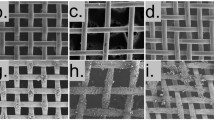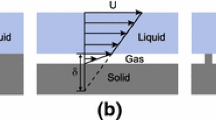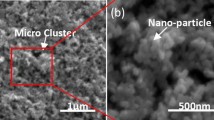Abstract
In this paper, a series of experiments are presented which demonstrate drag reduction for the laminar flow of water through microchannels using superhydrophobic surfaces with random surface microstructure. These superhydrophobic surfaces were fabricated with a simple, inexpensive technique of sanding polytetrafluoroethylene (PTFE) with sandpaper having grit sizes between 120- and 600-grit. A microfluidic device was used to measure the pressure drop as a function of the flow rate to determine the drag reduction and slip length of each surface. A maximum pressure drop reduction of 27 % and a maximum apparent slip length of b = 20 μm were obtained for the superhydrophobic surfaces created by sanding PTFE with a 240-grit sandpaper. The pressure drop reduction and slip length were found to increase with increasing mean particle size of the sandpaper up to 240-grit. Beyond that grit size, increasing the pitch of the surface roughness was found to cause the interface to transition from the Cassie–Baxter state to the Wenzel state. This transition was observed both as an increase in the contact angle hysteresis and simultaneously as a reduction in the pressure drop reduction. For these randomly rough surfaces, a correlation between the slip length and the contact angle hysteresis was found. The surfaces with the smallest contact angle hysteresis were found to also have the largest slip length. Finally, a number of sanding protocols were tested by sanding preferentially along the flow direction, across the flow direction and with a random circular pattern. In all cases, sanding in the flow direction was found to produce the largest pressure drop reduction.






Similar content being viewed by others
References
Barthlott W, Neinhuis C (1997) Purity of the sacred lotus, or escape from contamination in biological surfaces. Planta 202:1–8
Bocquet L, Barrat J-L (2007) Flow boundary conditions from nano- to micro-scales. Soft Matter 3:685–693
Bocquet L, Lauga E (2013) A smooth future? Nat Mater 10:334–337
Cassie ABD, Baxter S (1944) Wettability of porous surfaces. Trans Faraday Soc 40:0546–0550
Choi C-H, Ulmanella U, Kim J, Ho C-M, Kim C-J (2006) Effective slip and friction reduction in nanograted superhydrophobic microchannels. Phys Fluids 18:087105
Feuillebois F, Bazant MZ, Vinogradova OI (2009) Effective slip over superhydrophobic surfaces in thin channels. Phys Rev Lett 102:026001
Gogte S, Vorobieff P, Truesdell R, Mammoli A, van Swol F, Shah P, Brinker CJ (2005) Effective slip on textured superhydrophobic surfaces. Phys Fluids 17:051701
Hammer MU, Anderson TH, Chaimovich A, Shell MS, Israelachvili J (2010) The search for the hydrophobic force law. Faraday Discuss 146:299–308
Harting J, Kunert C, Hyvaluoma J (2010) Lattice Boltzmann simulations in microfluidics: probing the no-slip boundary condition in hydrophobic, rough, and surface nanobubble laden microchannels. Microfluid Nanofluid 8:1–10
Hebets EA, Chapman RF (2000) Surviving the flood: plastron respiration in the non-tracheate arthropod Phrynus marginemaculatus (amblypygi: Arachnida). J Insect Physiol 46:13–19
Hu DL, Chan B, Bush JWM (2003) The hydrodynamics of water strider locomotion. Nature 424:663–666
Jin MH, Feng XJ, Feng L, Sun TL, Zhai J, Li TJ, Jiang L (2005) Superhydrophobic aligned polystyrene nanotube films with high adhesive force. Adv Mater 17:1977
Lau KKS, Bico J, Teo KBK, Chhowalla M, Amaratunga GAJ, Milne WI, McKinley GH, Gleason KK (2003) Superhydrophobic carbon nanotube forests. Nano Lett 3:1701–1705
Lauga E, Stone HA (2003) Effective slip in pressure-driven stokes flow. J Fluid Mech 489:55–77
Lee C, Kim C-J (2009) Maximizing the giant liquid slip on superhydrophobic microstructures by nanostructuring their sidewalls. Langmuir 25:12812–12818
Lee JS, Ryu J, Park CB (2009) Bio-inspired fabrication of superhydrophobic surfaces through peptide self-assembly. Soft Matter 5:2717–2720
Li XH, Chen GM, Ma YM, Feng L, Zhao HZ, Jiang L, Wang FS (2006) Preparation of a super-hydrophobic poly(vinyl chloride) surface via solvent–nonsolvent coating. Polymer 47:506–509
Liu H, Feng L, Zhai J, Jiang L, Zhu DB (2004) Reversible wettability of a chemical vapor deposition prepared zno film between superhydrophobicity and superhydrophilicity. Langmuir 20:5659–5661
McHale G, Shirtcliffe NJ, Evans CR, Newton MI (2009) Terminal velocity and drag reduction measurements on superhydrophobic spheres. Appl Phys Lett 94:064104
Navier CLMH (1823) Memoire sur les lois du mouvement des fluides. Memoires de l'Academie Royal des Sciences de I'Institut de France 6:389–440
Nilsson M, Rothstein JP (2011) The effect of contact angle hysteresis on droplet coalescence and mixing. J Colloid Interface Sci 363:646–654
Nilsson M, Rothstein JP (2012) Using sharp transition in contact angle hysteresis to move and deflect droplets on a superhydrophobic surface. Phys Fluids 24:062001
Nilsson MA, Daniello RJ, Rothstein JP (2010) A novel and inexpensive technique for creating superhydrophobic surfaces using Teflon and sandpaper. J Phys D Appl Phys 43:045301
Nørgaard T, Dacke M (2010) Fog-basking behaviour and water collection efficiency in Namib Desert Darkling beetles. Front Zool 7:23
Oner D, McCarthy TJ (2000) Ultrahydrophobic surfaces: effects of topography length scales on wettability. Langmuir 16:7777–7782
Ou J, Rothstein JP (2005) Direct velocity measurements of the flow past drag-reducing ultrahydrophobic surfaces. Phys Fluids 17:103606
Ou J, Perot JB, Rothstein JP (2004) Laminar drag reduction in microchannels using ultrahydrophobic surfaces. Phys Fluids 16:4635–4660
Ou J, Moss GR, Rothstein JP (2007) Enhanced mixing in laminar flows using ultrahydrophobic surfaces. Phys Rev E 76:016304
Pietsch T, Gindy N, Fahmi A (2009) Nano- and micro-sized honeycomb patterns through hierarchical self-assembly of metal-loaded diblock copolymer vesicles. Soft Matter 5:2188–2197
Quere D (2008) Wetting and roughness. Annu Rev Mater Res 38:71–99
Reyssat M, Pepin A, Marty F, Chen Y, Quere D (2006) Bouncing transitions on microtextured materials. Europhys Lett 74:306–312
Richard D, Quere D (2000) Bouncing water drops. Europhys Lett 50:769–775
Rothstein JP (2010) Slip on superhydrophobic surfaces. Annu Rev Fluid Mech 42:89–109
Sbragaglia M, Prosperetti A (2007) Effective velocity boundary condition at a mixed slip surface. J Fluid Mech 578:435–451
Shirtcliffe NJ, McHale G, Newton MI, Perry CC, Pyatt FB (2006a) Plastron properties of a superhydrophobic surface. Appl Phys Lett 89:104106
Shirtcliffe NJ, Pyatt FB, Newton MI, McHale G (2006b) A lichen protected by a super-hydrophobic and breathable structure. J Plant Physiol 163:1193–1197
Singh A, Steely L, Allcock HR (2005) Poly[bis(2,2,2-trifluoroethoxy)phosphazene] superhydrophobic nanofibers. Langmuir 21:11604–11607
Srinivasan S, Choi W, Park K-C, Chhatre SS, Cohen RE, McKinley GH (2013) Drag reduction for viscous laminar flow on spray-coated non-wetting surfaces. Soft Matter 9:5691–5702
Tretheway DC, Meinhart CD (2002) Apparent fluid slip at hydrophobic microchannel walls. Phys Fluids 14:L9–L12
Tretheway DC, Meinhart CD (2004) A generating mechanism for apparent fluid slip in hydrophobic microchannels. Phys Fluids 16:1509–1515
Truesdell R, Mammoli A, Vorobieff P, van Swol P, Brinker CJ (2006) Drag reduction on a patterened superhydrophobic surface. Phys Rev Lett 97:044504
Voronov RS, Papavassiliou DV, Lee LL (2008) Review of fluid slip over superhydrophobic surfaces and its dependence on the contact angle. Ind Eng Chem Res 47:2455–2477
White FM (1991) Viscous fluid flow. McGraw-Hill, New York
Xu W, Choi C-H (2012) From sticky to slippery droplets: dynamics of contact line depinning on superhydrophobic surfaces. Phys Rev Lett 109:024504
Yamanaka M, Sada K, Miyata M, Hanabusa K, Nakano K (2006) Construction of superhydrophobic surfaces by fibrous aggregation of perfluoroalkyl chain-containing organogelators. Chem Commun (21):2248–2250
Yao LJ, Zheng MJ, He SG, Ma L, Li M, Shen WZ (2011) Preparation and properties of Zns superhydrophobic surface with hierarchical structure. Appl Surf Sci 257:2955–2959
Ybert C, Barentin C, Cottin-Bizonne C, Joseph P, Bocquet L (2007) Achieving large slip with superhydrophobic surfaces: scaling laws for generic geometries. Phys Fluids 19:123601
Zheng Y, Gao X, Jiang L (2007) Directional adhesion of superhydrophobic butterfly wings. Soft Matter 3:178–182
Author information
Authors and Affiliations
Corresponding author
Rights and permissions
About this article
Cite this article
Song, D., Daniello, R.J. & Rothstein, J.P. Drag reduction using superhydrophobic sanded Teflon surfaces. Exp Fluids 55, 1783 (2014). https://doi.org/10.1007/s00348-014-1783-8
Received:
Revised:
Accepted:
Published:
DOI: https://doi.org/10.1007/s00348-014-1783-8




